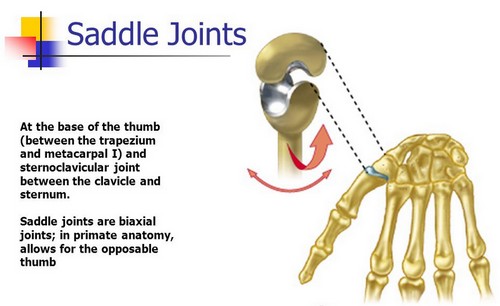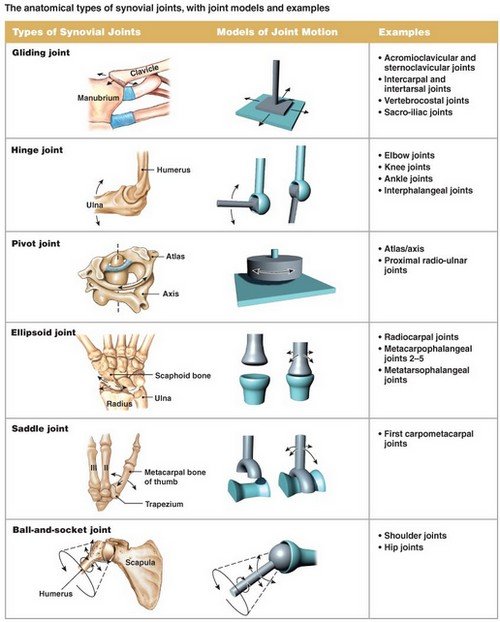There are different types of joints in the human body. The synovial joints are the most common. Because of synovial joints, people were able to move freely. Synovial joints enable you to walk, run, type, and write.
They are a complex joints characterized by articular cartilage that covers the ends of the bone. They have articular capsule containing fibrous connective tissues and lined with synovial membrane. They contain synovial fluid and ligaments and their role is to hold the bones together.
Synovial joints are freely movable. Where are synovial joints found in the body? They are located in between the bones of the limbs. (1, 2)

Picture 1: An image showing the location of saddle joints
Image Source : sphenoidbone.com

Photo 2: A table presentation of the different types of synovial joints in the human body
Picture Source: www2.highlands.edu
Different types of synovial joints
Synovial joints are grouped according to its shape and structure. The shape and structure of the joints can significantly affect the body’s movement. Synovial joints types include the following:
- Planar joints – The bones of planar joints have articulating surface, which is typically flat or slightly curved. It allows gliding joint movement. That’s why planar joint is also called gliding joints. However, the movement is limited. You cannot rotate this joint. An example of plane joint is carpal bones in the hand. The vertebrae and tarsal bones of the feet are also examples of planar joint. (2)
- Hinge joint – The purpose of hinge joint is to allow the movement of the bone while the other bone remained stationary. The slightly rounded end of the bone perfectly fits into the end of another bone. An example of hinge joint is the elbow.
- Pivot Joints – This type of joint permits rotational movement. For the bone to freely rotate, one bone should have a rounded end and it should perfectly fit the ring formed by another bone. The joint of the first and second vertebrae of the neck are examples of pivot joint. It is the pivot joints that allow you to move your head to move back and forth.
- Ball-and-Socket Joints – As the name suggests, one of the bones have a rounded, ball-like end while the other have a cup-like socket end. The ball and socket joints permit a full range of motion. The joints in the hips and shoulders are examples of ball and socket joints.
- Condyloid (ellipsoidal) Joints – the two connecting bones have both oval-shaped end. It facilitates angular movement along two axes. (3, 4, 5)
- Saddle Joints – The bones resemble a saddle. They both have concave and convex part that perfectly fit together. One of the bones resemble the shape of the saddle while other other bone is resting on it. What is saddle joint function? It keeps the bones stable and offers more flexibility as compared with other types of synovial joints. The bone that sits on the saddle can mimic the movement of the condyloid joint. The other name of saddle joint is sellar joint. What movement does a saddle joint allow? Saddle joints allow you to flex, extend, abduct, and adduct the bones. In fact, it allows circumduction. It also allows movement in the sagittal and frontal planes. In other words, saddle joints are biaxial. (5)
Example of saddle joint
Where saddle is joint located? It can be found in various parts of the body. Examples of saddle joints are the thumb joint. Through it, you can move the thumb in different directions (up, down, back, and forth).
In fact, the thumb is the only finger than can move freely. Specifically, the saddle joint structure is at the base of the thumb (carpal and metacarpal). The trapezium of the wrist is also categorized as saddle joint. (6)
How many saddle joints are in the body?
There are a total of four saddle joints in the human body. Specifically, the carpal-metacarpal joint of the thumb and the sternovlavicular joint. Although, anatomically speaking, the carpometacarpal joint of the thumb is the only saddle joint in the body. The patella that sits on the knee looks like a saddle, but is not considered a joint. (7)
Is the ankle joint a saddle joint?
The ankle joint is not a saddle joint. The primary bones in the ankle are talus, tibia, and fibula. Function wise, it is categorized as a hinge joint because it allows dorsiflexion and plantar flexion of the foot.
The role of joints in sports
- Saddle joint in sport –Any sports that require gripping are making use of saddle joint. Examples are tennis and golf. You use the saddle joint to hold the tennis racket and golf club. With the help of the saddle joint, you can move the bones back and forth and side to side. Saddle joints are also useful in productive movements like writing, sewing, painting a portrait, and pottery. In fact, a simple peeling of orange makes use of the saddle joint.
- Gliding joint/Planar joint – It is used in dribbling the ball in sports like hockey. It helps you move the hockey stick over and back.
- Hinge joint – Football players are using their hinge joints when kicking the ball. Hinge joints allow you to flex and extend the legs. It enables you to flex and extend the joint. This movement is useful when kicking the ball.
- Pivot joint – It is useful in sports like cricket and football. Bowling in cricket makes use of the pivot joint found in the forearm. In football, catching the ball using the head would need the help of the pivot joint found in the neck. Basically, any sports that require turning of the head uses pivot joints.
- Ball and socket joint – It is useful in sports like baseball. With the help of the ball and socket joint, you can throw and kick a ball. The ball and socket joint is the most useful joint when performing various sports activities because most sports require the use of legs and arms. (6, 7, 8, 9, 10)
References:
- www.innerbody.com
- https://en.wikipedia.org
- www.innovateus.net
- www.boundless.com
- www.teachpe.com
- www.biology-online.org
- www.mananatomy.com
- https://brentbrookbush.com
- www.ptdirect.com
- https://en.wiktionary.org


